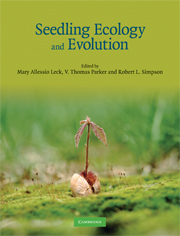Book contents
- Frontmatter
- Contents
- Contributors
- Foreword by Peter J. Grubb
- Preface
- Acknowledgments
- Part I Introduction
- Part II Seedling diversity
- Part III Seedling morphology, evolution, and physiology
- Part IV Life history implications
- Chapter 10 The seedling as part of a plant's life history strategy
- Chapter 11 Seedling recruitment and population ecology
- Chapter 12 Seedling communities
- Chapter 13 Spatial variation in seedling emergence and establishment – functional groups among and within habitats?
- Part V Applications
- Part VI Synthesis
- References
- Index
Chapter 13 - Spatial variation in seedling emergence and establishment – functional groups among and within habitats?
Published online by Cambridge University Press: 05 June 2012
- Frontmatter
- Contents
- Contributors
- Foreword by Peter J. Grubb
- Preface
- Acknowledgments
- Part I Introduction
- Part II Seedling diversity
- Part III Seedling morphology, evolution, and physiology
- Part IV Life history implications
- Chapter 10 The seedling as part of a plant's life history strategy
- Chapter 11 Seedling recruitment and population ecology
- Chapter 12 Seedling communities
- Chapter 13 Spatial variation in seedling emergence and establishment – functional groups among and within habitats?
- Part V Applications
- Part VI Synthesis
- References
- Index
Summary
Introduction
Based on over two centuries of biogeographical research starting with Schimper (1898) and supported by intensive ecological studies during the past decades, a synthesis of large-scale plant distribution patterns and plant functional types may now be possible (Box, 1996; Westoby & Wright, 2006). Plant functional types are nonphylogenetic species groups that show close similarities in their response to ecological factors (Duckworth et al., 2000). Functional types are derived from morphological, ecophysiological, and life history traits, often cutting across taxonomic groupings. One advantage of this approach is that some traits can be readily measured in the field and may act as surrogates for others, which require time-consuming laboratory measurements or experiments. Plant functional types are the ones suggested by Grime (1979, 2001), the three main traits determining plant performance as proposed by Westoby (1998), hierarchical classifications (Lavorel et al., 1997), or the seedling strategy types described by Keddy et al. (1998); the latter were experimentally tested by Carlyle and Fraser (2006). These conceptual frameworks and some older systems like the life-forms by Raunkiaer (1934) or the scheme devised by Hallé and Oldeman (1975), based on the reiteration of plant modules, may now be integrated into the biogeographical types of the world vegetation (Whittaker, 1970; Holdridge et al., 1971; Breckle, 2002), as done for seed dormancy and germination by Baskin and Baskin (2001).
- Type
- Chapter
- Information
- Seedling Ecology and Evolution , pp. 274 - 292Publisher: Cambridge University PressPrint publication year: 2008
- 1
- Cited by

